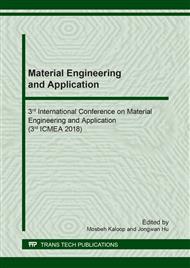[1]
K. Mori, K. Akita, Y. Abe, Springback behaviour in bending of ultra-high-strength steel sheets using CNC servo press, Int. J. Mach. Tool. Manuf. 47 (2007) 321–325.
DOI: 10.1016/j.ijmachtools.2006.03.013
Google Scholar
[2]
Y. Abe, T. Ohmi, K. Mori, T. Masuda, Improvement of formability in deep drawing of ultra-high strength steel sheets by coating of die, J. Mater. Proc. Tech. 214 (2014) 1838–1843.
DOI: 10.1016/j.jmatprotec.2014.03.023
Google Scholar
[3]
K. Mori, P. F. Bariani, B. A. Behrens, A. Brosius, S. Bruschi, T. Maeno, M. Merklein, J. Yanagimoto, Hot stamping of ultra-high strength steel parts, CIRP Ann. Manuf. Tech. 66 (2017) 755–777.
DOI: 10.1016/j.cirp.2017.05.007
Google Scholar
[4]
B. Sresomroeng, V. Premanond, P. Kaewtatip, A. Khantachawana, N. Koga, S. Watanabe, Anti-adhesion performance of various nitride and DLC films against high strength steel in metal forming operation, Diamond Relat. Mater. 19 (2010) 833–836.
DOI: 10.1016/j.diamond.2010.02.008
Google Scholar
[5]
B. Sresomroeng, V. Premanond, P. Kaewtatip, A. Khantachawana, A. Kurosawa, N. Koga, Performance of CrN radical nitrided tools on deep drawing of advanced high strength steel, Surf. Coat. Tech. 205 (2011) 4198–4204.
DOI: 10.1016/j.surfcoat.2011.03.010
Google Scholar
[6]
K. S. Oha, K. H. Oha, J. H. Janga, D. J. Kimb, K. S. Hana, Design and analysis of new test method for evaluation of sheet metal formability, J. Mater. Proc. Tech. 211 (2011) 695–707.
Google Scholar
[7]
C. D. Schwindt, M. Stout, L. Iurman, J. W. Signorelli, Forming limit curve determination of a DP-780 steel sheet, Proc. Mater. Sci. 8 (2015) 978–985.
DOI: 10.1016/j.mspro.2015.04.159
Google Scholar
[8]
M. Bhargava, A. Tewari, S. K. Mishra, Forming limit diagram of Advanced High Strength Steels (AHSS) based on strain-path diagram, Mater. Des. 85 (2015) 149–155.
DOI: 10.1016/j.matdes.2015.06.147
Google Scholar
[9]
W. Wang, C. He, Z. Zhao, X. Wei, The limit drawing ratio and formability prediction of advanced high strength dual-phase steels, Mater. Des. 32 (2011) 3320–3327.
DOI: 10.1016/j.matdes.2011.02.021
Google Scholar
[10]
H. J. Bong, F. Barlat, D. C. Ahn, H. Y. Kim, M. G. Lee, Formability of austenitic and ferritic stainless steels at warm forming temperature, Int. J. Mech. Sci. 75 (2013) 94–109.
DOI: 10.1016/j.ijmecsci.2013.05.017
Google Scholar
[11]
K. Kusumi, N. Nomura, S. Yamamoto, M. Nakata, M. Abe, M. Suehiro, Improvement of cylindrical deep drawability in hot stamping, Proc. Eng. 81 (2014) 1719–1724.
DOI: 10.1016/j.proeng.2014.10.220
Google Scholar
[12]
Y. Tokita, T. Nakagaito, Y. Tamai, T. Urabe, Stretch formability of high strength steel sheets in warm forming, J. Mater. Proc. Tech. 246 (2017) 77–84.
DOI: 10.1016/j.jmatprotec.2017.03.012
Google Scholar
[13]
J. G. Kim, S. M. Baek, J. I. Yoon, M. H. Seo, W. T. Cho, K. G. Chin, S. Lee, H. S. Kim, Stretchability and drawability of twinning-induced plasticity steel-cored layer steel sheets, J. Mater. Proc. Tech. 250 (2017) 357–362.
DOI: 10.1016/j.jmatprotec.2017.08.009
Google Scholar
[14]
L. Xu, F. Barlat, M. G. Lee, K. S. Choi, X. Sun, Hole expansion of dual phase steels, High Perform. Struct. Mater. VI (2012) 75–83.
Google Scholar
[15]
S. K. Paul, M. Mukherjee, S. Kundu, S. Chandra, Prediction of hole expansion ratio for automotive grade steels, Comput. Mater. Sci. 89 (2014) 189–197.
DOI: 10.1016/j.commatsci.2014.03.040
Google Scholar
[16]
X. Chen, H. Jiang, Z. Cui, C. Lian, C. Lu, Hole expansion characteristics of ultra high strength steels, Proc. Eng. 81 (2014) 718–723.
DOI: 10.1016/j.proeng.2014.10.066
Google Scholar
[17]
K. Mori, Y. Abe, Y. Suzui, Improvement of stretch flangeability of ultra high strength steel sheet by smoothing of sheared edge, J. Mater. Proc. Tech. 210 (2010) 653–659.
DOI: 10.1016/j.jmatprotec.2009.11.014
Google Scholar
[18]
H. Tschaetsch, Metal Forming Practise, Springer, Berlin Heidelberg, New York, (2006).
Google Scholar
[19]
M. Colgan, J. Monaghan, Deep drawing process: analysis and experiment, J. Mater. Proc. Tech. 132 (2003) 35–41.
Google Scholar
[20]
R. Padmanabhan, M. C. Oliveira, J. L. Alves, L. F. Menezes, Influence of process parameters on the deep drawing of stainless steel, Fin. Element. Anal. Des. 43 (2007) 1062–1067.
DOI: 10.1016/j.finel.2007.06.011
Google Scholar
[21]
H. Zein, M. El Sherbiny, M. Abd-Rabou, M. El shazly, Thinning and spring back prediction of sheet metal in the deep drawing process, Mater. Des. 53 (2014) 797–808.
DOI: 10.1016/j.matdes.2013.07.078
Google Scholar


